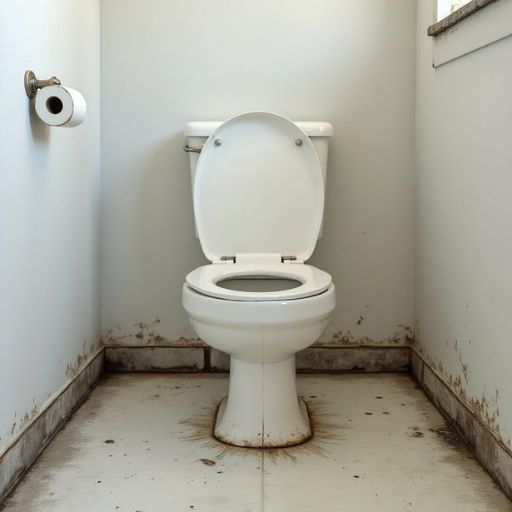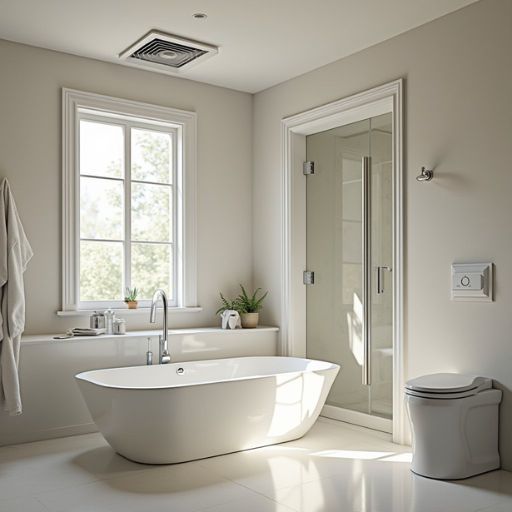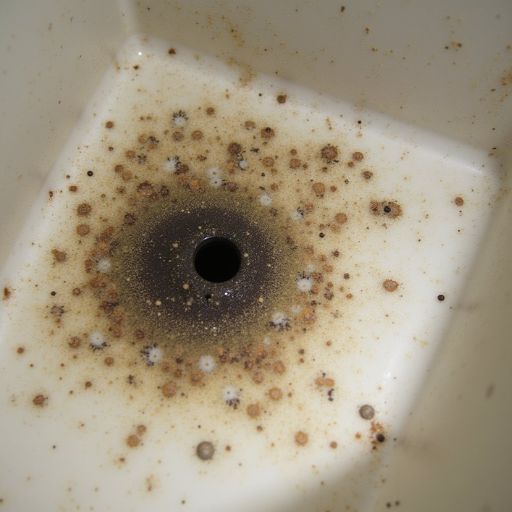17 Toxic Black Mold Spots You’re Missing in Your Bathroom (Warning: Check #9!)
Did you know that 70% of bathrooms contain hidden mold growth that homeowners don’t discover until it’s become a serious problem?
You’re probably familiar with obvious spots like shower grout and window sills, but dangerous black mold often lurks in less obvious places throughout your bathroom.
While some of these hiding spots might seem harmless, they can harbor Stachybotrys chartarum, a toxic variety of mold that poses significant health risks to you and your family.
Before you assume your bathroom is clean, you’ll want to check these 17 commonly overlooked areas – especially number 9, which might surprise even the most thorough cleaners.

Behind Your Bathroom Mirror
Black mold tends to creep up behind bathroom mirrors due to the constant humidity and poor ventilation in this enclosed space.
When moisture gets trapped between your mirror and wall, it creates an ideal breeding ground for toxic spores, especially if your mirror isn’t properly sealed.
To check for hidden mold growth, carefully remove your mirror from its mounting brackets.
You’ll need a flathead screwdriver and protective gloves.
Inspect the wall surface, looking for black, green, or dark brown spots.
Don’t ignore any musty odors – they’re telltale signs of active mold colonies.
If you discover mold, you’ll need to remove the mirror completely, clean both surfaces with a specialized mold killer, and guarantee proper sealing during reinstallation.
Consider installing a bathroom fan to prevent future moisture accumulation.
Under the Toilet Tank

Much like the hidden space behind your mirror, the area beneath your toilet tank harbors moisture-prone conditions that fuel toxic mold growth.
Condensation forms on the tank’s exterior when warm bathroom air meets the cool porcelain surface, creating persistent dampness where the tank meets the toilet bowl.
You’ll need to detach the tank to properly inspect this area. First, shut off the water supply valve and flush to empty the tank.
Remove the mounting bolts connecting the tank to the bowl, then lift the tank straight up.
Examine the rubber gasket and surrounding surfaces for black, green, or brown spots.
Don’t ignore the underside of the tank itself, where condensation often creates perfect conditions for Stachybotrys chartarum (toxic black mold) to thrive.
Inside Cabinet Door Hinges
Your bathroom’s cabinet hinges provide an ideal environment for toxic mold growth, particularly where metal components meet wooden surfaces.
The constant moisture from shower steam and sink splashes gets trapped in these tight spaces, creating perfect conditions for black mold colonization.
To inspect your hinges, you’ll need to open the cabinet door fully and examine both the door-side and frame-side mounting points.
Don’t forget to check beneath the hinge plates where screws penetrate the wood.
If you spot dark spots or fuzzy patches, you’re likely dealing with toxic mold that’s already eating into your cabinetry.
Use a mixture of vinegar and water to clean affected areas, and consider replacing severely corroded hinges.
Installing moisture-resistant hinges and maintaining proper bathroom ventilation will help prevent future mold issues in these often-overlooked spots.
Exhaust Fan Housing

Almost every bathroom exhaust fan housing becomes a prime collection point for toxic black mold, as the unit’s dark, damp environment provides ideal growing conditions.
You’ll find the most severe accumulation on the fan blades, motor housing, and vent duct connection points, where condensation regularly forms during temperature fluctuations between shower sessions.
To inspect your fan housing, remove the cover plate and shine a bright LED flashlight into the cavity.
Look for black or dark green patches, especially in corners and on metal surfaces.
Don’t forget to check the flexible duct material, as mold often spreads several feet into the ventilation system.
If you spot mold growth, you’ll need to disconnect power, remove the entire unit, and clean it thoroughly with a fungicidal solution specifically designed for HVAC components.
Beneath Loose Floor Tiles
Over time, loose bathroom floor tiles create the perfect environment for toxic black mold to thrive in the dark, moist space underneath.
When water seeps through cracked grout or damaged caulking, it becomes trapped beneath the tiles, creating an ideal breeding ground for dangerous spores.
You’ll need to inspect your bathroom floor regularly for signs of loose tiles, which often make subtle clicking sounds when you walk on them.
Don’t ignore these warning signs. If you spot any tiles that wiggle or sound hollow when tapped, you’re likely dealing with water damage and potential mold growth underneath.
Remove the affected tiles immediately to assess the situation.
Black spots or a musty odor indicate you’ve got a serious mold problem that requires immediate attention to protect your health and prevent further structural damage.
Around Plumbing Access Panels

Plumbing access panels in bathrooms frequently harbor toxic black mold due to constant moisture exposure from pipe condensation and minor leaks.
You’ll need to inspect these areas regularly by removing the panel covers and examining the surrounding drywall, insulation, and pipe joints with a flashlight.
Check for discolored patches, musty odors, or surface irregularities that might indicate mold growth.
Don’t overlook the panel’s edges where caulk or weatherstripping may have degraded, creating entry points for moisture.
Your inspection should include feeling the wall surface for sponginess, which suggests hidden water damage.
If you spot black mold, you’ve got two choices: tackle small areas yourself using appropriate protective gear and antimicrobial cleaners, or call a professional for extensive contamination.
Remember to address any plumbing issues immediately to prevent future mold growth.
Behind Wall-Mounted Fixtures
Wall-mounted fixtures regularly create prime conditions for toxic black mold growth due to their mounting configurations and susceptibility to water intrusion.
When you mount towel bars, soap dishes, or shelving units directly onto bathroom walls, you’re creating potential water trap points where moisture can seep behind the mounting plates and brackets.
To check these areas, you’ll need to remove the fixtures completely from the wall.
Look for dark spots, fuzzy patches, or discoloration around mounting holes and behind backplates.
Pay special attention to fixtures near your shower or sink where water splash is common.
If you spot any signs of mold, don’t just clean the surface – you’ll need to address the underlying moisture issue and potentially replace affected drywall.
Consider using silicone sealant around mounting points to prevent future water infiltration.
Under Your Bathroom Scale

Another hidden spot where toxic black mold can thrive sits right beneath your feet – the underside of your bathroom scale.
The scale’s base creates an ideal microenvironment for mold growth by trapping moisture from shower steam and floor cleaning.
This dark, damp space becomes a perfect breeding ground for Stachybotrys chartarum and other toxic species.
You’ll need to lift your scale weekly to inspect and clean underneath it.
Look for black, green, or dark brown patches on both the floor and the scale’s underside.
If you spot mold, immediately clean the area with a mixture of vinegar and water or a commercial anti-fungal solution.
Consider placing your scale on a raised platform or moving it outside the bathroom entirely to prevent future mold colonization.
Inside Light Switch Plates
Light switch housings and electrical junction boxes in bathrooms create hidden spaces where toxic black mold can flourish undetected.
When warm, moist air seeps behind your switch plates, it condenses on the cooler surfaces inside, providing ideal conditions for mold growth.
You’ll need to check these areas regularly, especially if you’ve noticed a musty smell near your switches.
To inspect for mold, turn off the circuit breaker first, then remove the switch plate carefully.
Look for black, dark green, or brown spots on the back of the plate, around the switch housing, and inside the junction box.
If you spot mold, don’t just clean the surface – you’ll need to address the moisture source.
Consider installing a bathroom fan, sealing gaps around fixtures, or consulting an electrician if you find extensive contamination.
Shower Curtain Rod Interior

Hidden inside your shower curtain rod, toxic black mold can establish colonies that often go undetected for months or years.
The hollow interior of tension rods and mounted rods provides an ideal dark, moist environment where Stachybotrys chartarum thrives, particularly when bathroom ventilation is poor.
You’ll need to disassemble your curtain rod completely to inspect for black mold growth.
Check both end caps and the rod’s inner surface using a flashlight.
If you spot dark patches or a musty odor, you’re likely dealing with toxic mold colonization.
Don’t attempt to clean the rod’s interior – replace it immediately.
To prevent future growth, seal any new rod’s ends with silicone caulk and maintain proper ventilation.
Consider switching to a solid rod design that eliminates internal cavities where mold can flourish.
Below Sink Drain Pipes
Black mold frequently colonizes the intricate network of drain pipes beneath bathroom sinks, where constant moisture and organic debris create perfect conditions for Stachybotrys chartarum growth.
You’ll need to inspect both the P-trap and connecting pipes regularly, as these areas accumulate biofilm that feeds toxic mold colonies.
To check for contamination, you’ll want to use a flashlight to examine the pipe joints, connectors, and surrounding cabinetry for black or dark green patches.
Don’t ignore even minor leaks or condensation, as these provide the water activity levels necessary for rapid mold proliferation.
If you spot mold growth, you’ll need to disconnect the affected pipes, clean them with a commercial fungicide, and guarantee proper sealing of all connections.
Consider installing moisture-detecting sensors to alert you of potential leaks before mold can establish itself.
Window Track Crevices

Mold-prone window tracks in bathroom environments serve as prime real estate for toxic black mold development, particularly in the deep grooves and corners where condensation collects.
You’ll find these microscopic spores thriving in the aluminum or vinyl channels where your window slides, especially if you’re not maintaining proper ventilation during hot showers.
To combat this health hazard, you’ll need to thoroughly inspect the entire track system, including weep holes and weather stripping.
Don’t overlook the corners where the vertical and horizontal tracks meet – they’re notorious breeding grounds.
You can prevent mold growth by regularly wiping down tracks with a vinegar solution, ensuring proper drainage through weep holes, and immediately addressing any signs of water pooling.
Consider installing a bathroom fan if you haven’t already, as it’ll greatly reduce window condensation.
Bathroom Door Bottom Edge
Lingering moisture seeps beneath your bathroom door’s bottom edge, creating an ideal breeding ground for toxic black mold, particularly in homes with carpeted hallways or frequent shower use.
You’ll need to inspect both sides of the door’s bottom edge carefully, as condensation often accumulates in this overlooked area.
Use a flashlight to examine the wood’s surface, looking for dark spots or fuzzy patches.
Don’t forget to check the rubber sweep or weather stripping, if installed, as these materials can trap moisture and accelerate mold growth.
To prevent future contamination, you must maintain proper ventilation and consider installing a door sweep with antimicrobial properties.
If you spot mold, remove it immediately using a solution of one part hydrogen peroxide to two parts water, then thoroughly dry the area with a microfiber cloth.
Behind Toilet Paper Holder

The often-neglected space behind your toilet paper holder creates a perfect environment for toxic black mold growth due to trapped condensation and paper debris accumulation.
You’ll need to detach the holder from your wall periodically to inspect and clean this hidden area, as paper fibers and moisture combine to form an ideal breeding ground for Stachybotrys chartarum.
To prevent mold colonization, remove the holder’s mounting bracket and thoroughly clean the wall surface with a hydrogen peroxide solution.
Don’t forget to check the screw holes and surrounding drywall for signs of water damage or discoloration.
If you spot black spots or fuzzy patches, you’ll need to treat the area immediately with a commercial mold killer and possibly replace affected drywall sections to maintain your bathroom’s air quality and structural integrity.
Caulk Line Gaps
Frequently overlooked caulk line gaps between your bathroom tiles and fixtures serve as prime entry points for moisture infiltration and subsequent toxic black mold development.
These seemingly minor imperfections can harbor dangerous spores that thrive in the damp, dark environments behind your tiles and fixtures.
You’ll need to inspect all caulk lines carefully, paying special attention to the seams where your tub meets the wall, around your toilet base, and along your sink’s backsplash.
Look for signs of separation, cracking, or discoloration – these indicate compromised barriers.
Don’t ignore even the smallest gaps, as they’re potential breeding grounds for Stachybotrys chartarum, the scientific name for toxic black mold.
For proper remediation, you’ll need to remove old caulk completely, treat any existing mold, and reseal with a high-quality, mold-resistant silicone caulk.
Between Vanity and Wall

Because bathroom vanities often sit flush against walls without proper sealing, this junction creates an ideal environment for toxic black mold growth.
Water from splashing, cleaning, and condensation seeps into this gap, becoming trapped between the vanity’s backside and your wall’s surface.
You’ll need to pull your vanity slightly away from the wall to inspect this area properly.
Use a flashlight to look for black, green, or dark brown spots along both surfaces.
If you discover mold, don’t just reseal the gap – you must address the underlying issue.
Remove the vanity completely, clean both surfaces with a mold-killing solution, and let them dry thoroughly.
Before reinstalling, apply a waterproof sealant along the vanity’s back edge and wall junction to prevent future water infiltration.
Towel Bar Mounting Points
Mounting points for towel bars represent another vulnerable area where toxic black mold can establish colonies in your bathroom.
The hollow spaces behind these mounting brackets create perfect microclimates for mold growth, especially when moisture seeps through microscopic gaps in the caulking or grout.
You’ll need to inspect both the mounting hardware and the surrounding wall surface carefully.
Look for telltale black or dark green spots, which often appear first at the screw holes where the bracket meets the wall.
If you detect a musty odor or notice any discoloration, immediately remove the towel bar and examine the wall cavity behind it.
Don’t ignore the silicone sealant around the mounting points – it’s essential to replace it at the first sign of degradation to prevent water infiltration that feeds mold growth.
FAQs
How Long Does Toxic Black Mold Take to Make Someone Sick?
You’ll notice toxic black mold symptoms within 2-9 days of exposure, though your sensitivity level matters. You could experience immediate reactions or develop illness gradually over weeks, depending on your immune system’s response.
Can Black Mold Spread to Other Rooms Through Bathroom Walls?
Keep your eyes peeled – black mold can definitely spread through bathroom walls into adjacent rooms. It travels through drywall, insulation, and air ducts, especially when there’s moisture present in your home’s structure.
Which Cleaning Products Effectively Kill Black Mold Without Damaging Bathroom Surfaces?
You’ll effectively eliminate black mold using vinegar, hydrogen peroxide, or commercial fungicides containing benzalkonium chloride. Don’t mix products. Apply directly, let sit 10 minutes, and scrub with a non-abrasive brush for safe removal.
Does Homeowner’s Insurance Cover Black Mold Removal and Remediation?
Like threading a legal maze, your insurance coverage for mold depends on the cause. You’ll typically get coverage if it’s from a sudden event (burst pipe), but not from maintenance neglect or long-term water issues.
What Humidity Level Should Bathrooms Maintain to Prevent Black Mold Growth?
You’ll want to maintain your bathroom’s relative humidity below 60%, ideally between 30-50%. Installing an exhaust fan, running it during showers, and keeping it on 15-20 minutes afterward helps achieve this ideal range.
Final Thoughts
You’ve diligently checked sixteen spots, but let’s face it – you’re still harboring toxic spores behind that innocent-looking towel bar.
While you’re scrubbing away at visible surfaces, Stachybotrys chartarum is hosting a microscopic party in those mounting holes.
Don’t let your bathroom’s pristine appearance fool you; it’s time to dismantle those seemingly benign fixtures and confront the biochemical reality lurking within your walls.